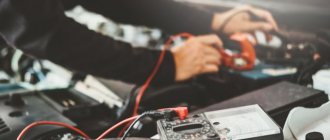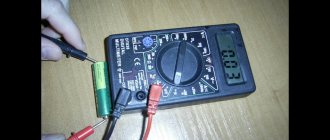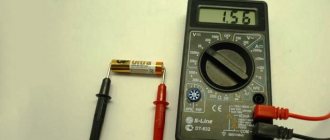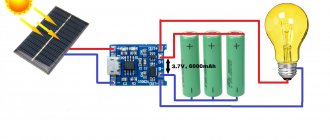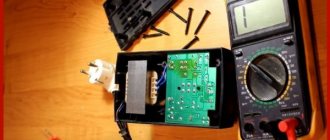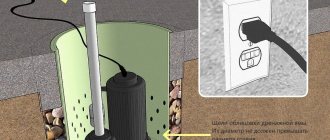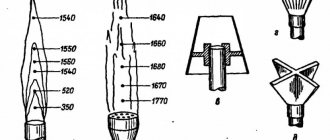Why does the starter take on a lot of current?
Hello, dear motorists!
Nothing cheers up our fellow car enthusiast more than starting a car engine with the first turn of the key in the ignition. If several attempts to start the car do not lead to the desired result, the mood is ruined for a long time. The car starting system, as it seems to drivers, is quite complicated and there is no desire to understand it.
As soon as problems arise with leaving the garage, we begin to look for a familiar “specialist mechanic”. Although difficulties that often arise can be eliminated in a matter of seconds with your own hands.
It is necessary to delve into the design of the starter and other parts that are involved in the engine starting procedure for the simple reason that the machine may be needed very urgently.
Often breakdowns occur far from service centers and experienced garage neighbors who can give practical advice or help. In fact, the biggest problem in repairing the starting system is the procedure for removing and installing the starter, since it is installed in a very inconvenient place. The rest is a matter of technique.
Why does the starter take over the current and how does this happen?
The difficult process of starting the engine leads us to service technicians, where knowledgeable specialists, without looking, say, “The starter takes over.” At this moment you feel a certain awkwardness, as even more questions arise.
Firstly, it is not at all clear what exactly the starter takes on? Secondly, why does he behave this way and what to do about it. After some time, it becomes clear that the “specialists” mean the starter’s inrush current.
Obviously, to start the engine, the starter needs a certain amount of electrical energy, the reserve of which in the battery ensures repeated starting of the engine. A clear sign of increased energy consumption is a significant decrease in the brightness of the lighting bulbs and dashboard displays.
Understanding the essence of the ongoing processes leads to three different options for possible problems:
If there is a charged battery and reliable connection of all systems, absolutely nothing prevents an absolutely serviceable starter from performing its function. However, as soon as some obstacle gets in the way, he also tries to do his job, but with much greater energy consumption.
What to do if the starter takes on a lot of energy?
If the starter takes on a lot of current, then it is impossible to say unequivocally about the reasons for this phenomenon and, accordingly, there is no, and there cannot be a universal recipe for treating this “illness”.
However, we can say that in most cases, a simple cleaning of the electrical circuit contacts, starting from the battery and ending with the final electrical device, helps to cure such a malfunction, like this and many others.
If cleaning the contacts did not help, then you will have to look deeper. It should be borne in mind that clogging of the brush assembly and contact groups inside the starter or retractor relay also often causes malfunctions of the starter.
Mechanical obstacles in the operation of the starter can be due to two groups of reasons:
It is clear that to repair most breakdowns, you will have to remove and disassemble the starter, and also seek help from specialists who, using special instruments, will be able to assess the condition of the starter windings and other parts.
There is a situation where the starter takes over the current and ultimately this leads to the battery being discharged faster. This situation frightens many people and they immediately go to a service center, but in fact, the problem when the starter drains the battery too much is not very serious and you can fix it yourself.
The starter is not so simple and there is usually no time to study its design, because the main thing is that it works correctly, especially at the moment when you need to drive the car somewhere. As for repairing the starter, it is quite simple if you know what to do, it’s just inconvenient to remove it from the engine, and repairing it is relatively not difficult.
Why does the battery discharge by itself? Dealing with leakage current
Many people are familiar with this situation: a car sits on the street for two or three days without moving, and when you try to get into it and drive it somewhere, instead of the vigorous sound of the starter rotating, you hear only the clicks of the overrunning clutch or nothing at all. The battery is dead. Why? Why does it discharge on its own? And what should you do now: run for a new one, charge this one, call a friend or get help from the gym?
Little by little
Simple times are long gone. Approximately in that bright era when cars acquired electronic devices in the form of radios, immobilizers, security systems, navigators, radar detectors and other things powered by the on-board network. And don’t forget about, for example, electronic control units for the engine, gearbox and other components that also consume current. Some of these devices consume electricity even when the car is turned off. Their consumption is small and the battery cannot be discharged quickly. But there are three classic situations when current consumption becomes more than necessary.
First reason
, due to which the current consumption becomes too large, this is the incorrect installation of some of these devices. The same radio tape recorder can be installed in such a way that it will work, but at the same time something will be shorted somewhere. I generally keep quiet about the alarm system - a lot of trouble can be caused there.
The second reason
- ordinary absent-mindedness. You may forget that, for example, you need to turn off the lights in the cabin or take out the DVR from the cigarette lighter. Not all cars are able to “warn” about the lights not being turned off and turn off the power to the cigarette lighter after turning off the ignition. However, this is not exactly our situation.
How to check whether the starter engages or not?
In order for the engine to start, the starter needs a certain amount of energy to turn it. If at the moment of starting the engine the brightness on the instrument panel decreases greatly, then this is the first sign that the starter is taking over.
Another way to find out if the starter is taking over is to listen to how the starter spins while turning the ignition key. If it spins sluggishly and feels like it will stop spinning altogether, then this could also be a sign. But first of all, you need to check the condition of the battery and how the terminals are connected to it.
Usually there are such problems due to which the engine cannot start normally:
If the battery is charged, the wiring is also in order, and everything is in order in the starter, then the engine will start quickly and without unnecessary energy consumption. And when any obstacle appears, for example, everything inside the starter is rusty, then the starter will function, but at the same time it will take on more energy. In general, you will have to disassemble the starter in any case, because you can’t tell by eye.
Advice to a car owner
All external contacts of the starter should be cleaned before checking, since this is a fairly common malfunction and there is no need to remove it from the engine.
Even an initial check of the starter without removing it from the vehicle usually indicates a breakdown, reducing repair time, reducing costs and not taking much time.
- Posts: 3
October 31, 2012, 01:12 #1 123
In winter, at minus 20 and below, I could not start the engine. The starter turns for the first time, then sluggishly until the battery dies. I installed a new battery, same thing, but in the summer, no problem. They say the starter takes a lot of load. Tell.
- Posts: 24
- From: Saratov region
- Lada 2112 ZIL 5301 Bychok PO
October 31, 2012, 5:39 pm #2 123
What brand of car?
- Posts: 3
October 31, 2012, 10:19 pm #3 123
Opel Vectra 1990
- Posts: 3545
- From: Zaporozhye
- UAZ Patriot
November 1, 2012, 00:17 #4 123
If the starter “takes over”, it is repaired, and there may be an “anchor”, perhaps a stator, a gearbox (in some), bushings, etc., or maybe a mass for the motor. worthless
- Posts: 8523
- From: Russia, our Russia
- Ford Focus
November 1, 2012, 00:24 #5 123+ 1
Most likely it is a shoe, that is, the bushings on the rotor are broken and under load they cling to the stator. An autopsy will show!
- Posts: 3545
- From: Zaporozhye
- UAZ Patriot
November 1, 2012, 00:32 #6 123+ 1
Last Sunday, a relative in a Kamaz truck barely made it to Zaporozhye, didn’t turn off the car and got off the hill, there was a stator and bushings there. Kamaz, Opel, the starter principle is the same.
- Posts: 2605
- From: Saratov.
- Peugeot Partner Tepee
November 1, 2012, 00:49 #7 123
bogdannn, October 31, 2012, 10:19 pm, #3
Opel Vectra 1990
Prmchina - starter. In particular the bushings.
Unfortunately, you did not specify the modification. Approximately starter assembly from 7 tr. bushings from 30 RUR
- Posts: 3
November 1, 2012, 01:31 #8 123
Thanks, I'll try it
- Posts: 12128
- From: Vladimir
- Oka AvtoVAZ Oka
November 6, 2012, 11:56 pm #9 123
Z969, November 1, 2012, 00:17, #4
If the starter “takes over”, it is repaired, and there may be an “anchor”, perhaps a stator, a gearbox (in some), bushings, etc., or maybe a mass for the motor. worthless
Read also: Arrester on an electrical diagram
My Oka (newly purchased) did not have a bushing. and the starter did not turn well exactly as the author of the topic indicated.
- Posts: 46
- From: Moscow
November 15, 2012, 16:59 #10 123
In addition to the problem with the starter itself, in winter, during rare or short trips, the battery charges worse. Hence the problem. But you need to deal with the starter, yes.
- Posts: 5
November 25, 2014, 12:16 #11 123
The battery drains when starting when the engine is cold! Bought a new starter and batteries! what could it be?
- Posts: 2195
- From: Samara
November 25, 2014, 1:18 pm #12 123+ 2
AJIEKCEEBKA, November 25, 2014, 12:16, #11
The battery drains when starting when the engine is cold! Bought a new starter and batteries! what could it be?
Buy normal oil for winter and you will be happy.
- Posts: 589
- From: Zhigulevsk
- Chevrolet Niva LC Vortex Estina
November 25, 2014, 1:36 pm #13 123
Measure the voltage on the batteries under load (when you turn the starter). It should not fall below 16V, if lower, perhaps 1 battery is weak, maybe both. If the voltage is normal, check the wire contacts: starter housing-frame, ground switch-frame, ground switch contacts.
I speak like an old mazist-kamazit.
- Posts: 5
November 26, 2014, 00:38 #14 123
actros, November 25, 2014, 13:18, #12
Buy normal oil for winter and you will be happy.
there was no frost yet -5 -10
- Posts: 5
November 26, 2014, 00:40 #15 123
I put the dead batteries in another car and it starts.
- Posts: 14551
- From: 66, Ekaterinburg
- UAZ Hunter 315195 ZIL 5301 Bull
November 26, 2014, 06:24 #16 123
AJIEKCEEBKA, November 26, 2014, 00:38, #14
there was no frost yet -5 -10
What kind of oil is in?
- Posts: 13
November 26, 2014, 07:42 #17 123
Check for current leakage! It seems like you remove the positive terminal from the battery, I don’t remember where to put the multimeter and measure it. In short, you need to google “check current leakage”. My alarm system was eating up the battery at night.
- Posts: 589
- From: Zhigulevsk
- Chevrolet Niva LC Vortex Estina
November 26, 2014, 09:41 #18 123
AJIEKCEEBKA, November 26, 2014, 00:40, #15
I put the dead batteries in another car and it starts.
Read my post above carefully. You have a weak connection somewhere. Clean all the contacts I indicated with a file. There, the currents are very high during startup, a voltage drop is possible, which is what the starter lacks.
- Posts: 11844
- Where:
November 26, 2014, 11:26 #19 123
bogdannn, October 31, 2012, 01:12, #1
In winter, at minus 20 and below, I could not start the engine. The starter turns for the first time, then sluggishly until the battery dies. I installed a new battery, same thing, but in the summer, no problem. They say the starter takes a lot of load. Tell.
Most likely the generator is not recharging the battery.
- Posts: 5
November 26, 2014, 5:51 pm #20 123
vadim20, November 26, 2014, 06:24, #16
What kind of oil is in?
- Posts: 5
November 26, 2014, 17:53 #21 123
RW4HJD, November 26, 2014, 09:41, #18
Read my post above carefully. You have a weak connection somewhere. Clean all the contacts I indicated with a file. There, the currents are very high during startup, a voltage drop is possible, which is what the starter lacks.
understandable, probably because of the mass.
- Posts: 2195
- From: Samara
November 26, 2014, 5:58 pm #22 123
AJIEKCEEBKA, November 26, 2014, 17:53, #21
understandable, probably because of the mass.
It doesn’t take long to find out - one starts it and the other stands next to the batteries and watches. If there is a bad contact, you can notice it. If it’s not visible, then by touch, where it gets very hot - the battery terminals, fastening the wires to the main switch and from it to the frame and on the starter itself there is a positive one from the battery. If everything is cold, then the contact is good everywhere and there is no leakage to heating anywhere.
The starter began to drain the battery. The battery is new, even two! After you turn the starter, the positive terminal on the battery gets very hot (burns) as a result of the battery going to zero and the starter starts clicking. I took the starter apart and looked at it, cleaned all the terminals. It just started to heat up less the starter, but it still turns very sluggishly and won’t start, and the terminal still burns even though I cleaned it.
WHAT DO YOU RECOMMEND?
Common starter faults
Thanks to the starter, the car engine starts. It receives power from the battery. If the starter does not work or rotates at low speeds, you should check the battery and wiring.
Starter connection diagram
The following malfunctions are possible:
If the starter does not turn on, the cause may be a faulty relay or a short circuit in the windings of the device itself. If, when the armature rotates, the crankshaft does not rotate, it is possible that the clutch is slipping or the screw thread drive is running tight.
Tips for extending battery life
Like other elements and systems of any vehicle, the battery requires proper and regular maintenance.
The following measures will help extend battery life:
- The battery must be fully charged at least once every 6 months.
- It is necessary to regularly check the condition of the electrical wiring in the car. If malfunctions occur, they must be eliminated immediately.
- To prevent corrosion, the battery terminals and pole terminals must be treated with a special lubricant.
- It is necessary to regularly monitor the density and level of electrolyte.
- It is necessary to periodically clean the battery terminals and terminals from contamination.
These tips will help extend the life of your car battery.
What to do if the starter takes over the current?
When you find out that the starter is draining the battery too much, you must first clean all the contacts in the network; sometimes it’s enough just to clean the battery terminals.
But if this does not help, then you need to take out the starter and disassemble it; perhaps the brush assembly, solenoid relay or other contacts are clogged inside.
To summarize, in most cases, there are reasons why the starter takes over on the VAZ 2109 and other domestic cars such as the VAZ 2114 and VAZ 2106:
As a result, if you understand that the starter takes over in a GAZ 53 or GAZ 66, then you will certainly have to disassemble the starter, and this is a rather complicated procedure, so if you have no experience, then it is better to immediately contact specialists. Also, if you don’t want to tinker with the starter, diagnose it, make repairs, you can do it simpler - buy a new starter, but it will cost a lot of money, but then the problem with starting the engine will no longer be a problem and the car will begin to bring only joy, because It will start with half a turn.
And then a quick video on how to check the starter:
Almost every motorist may encounter a situation where the car eraser can begin to take over the current. There is little pleasure in this moment, especially since this can lead to the fact that the battery simply begins to discharge much faster. Most motorists are very lost in this case and, instead of figuring out the problem, they immediately rush to seek help from specialists. In fact, such a violation is considered not too serious and can be corrected with one’s own hands. The main thing is to accurately determine the order of actions. This useful material will tell you in detail how you can do this on your own.
Reasons for car battery drain
No matter how good and high-quality the battery you choose, in some situations it can still fail. Therefore, you shouldn’t be surprised that your car’s battery dies overnight, even if it’s new. There are reasons for this situation. The main reasons are presented below:
- The battery has exhausted its service life;
- the battery is not charged from the generator during the trip;
- current leakage in the on-board network;
- left the devices in the car on (headlights, heating, radio);
- temperature conditions (severe frost).
Now, let's look at these reasons in more detail. Return to content
Video instructions for checking current leakage
1) The presented video is dedicated to the main features of starter troubleshooting.
The video clearly shows the diagnostics of all starter components with a detailed description of the characteristic malfunctions of the main operating elements.
2) We present to your attention an overview video on starter repair.
It is for informational purposes only and is intended to introduce a wide range of car owners to the key stages of diagnostics and repair of the starter.
Repairing a starter for the most part should not cause serious difficulties for its owner. It is important to remember that the sooner you respond to a malfunction, the easier it will be to fix it.
Almost every motorist may encounter a situation where the car eraser can begin to take over the current. There is little pleasure in this moment, especially since this can lead to the fact that the battery simply begins to discharge much faster. Most motorists are very lost in this case and, instead of figuring out the problem, they immediately rush to seek help from specialists. In fact, such a violation is considered not too serious and can be corrected with one’s own hands. The main thing is to accurately determine the order of actions. This useful material will tell you in detail how you can do this on your own.
Checking the starter: how to do it?
First of all, it is important to understand that a certain amount of energy is required to start the engine. It is due to this that the starter is activated. When the brightness of the lighting on the dashboard decreases significantly at the moment the engine starts, this may be the first sign that the starter is taking over the current. In addition, this can be determined through another simple manipulation. To do this, you need to listen to exactly how the starter rotates when you turn the ignition key. If the starter rotates sluggishly or even on the verge of stopping completely, this may also indicate that it is taking over the current. However, in this situation, you first need to check the condition of the car battery itself and the correct connection of the terminals to it. Basically, the engine may be difficult to start for the following reasons:
In the case when everything is in order with the wiring, and the battery is fully charged, the engine will start quickly. If any of these violations are present, the starter can function, but at the same time it will take an excessive amount of energy for its work.
Your car's battery suddenly runs out: are you sure you're not distracted?
A simple reason for losing all charge literally overnight could be elementary absent-mindedness. For example, when parking the car, the owner forgot to turn off the lights or the music. Therefore, rule No. 1 is to remember/check whether all electrical appliances connected bypassing the ignition switch were de-energized.
We recommend checking it out, especially if there are children in the family who are partial to the car. Sitting in the driver's seat as a child, there is a desire to twist everything that turns, including the buttons that turn on the consumers.
Well, and a cigarette lighter. It works in almost all cars, even when the keys are far from the ignition switch. This means that the navigator, recorder and other non-standard gadgets steal current from the battery when it is idle. Therefore, make it a habit to unplug all cords from the socket when parking your car for a long time.
Proven ways to close the starter directly: recommendations from the pros
Starter connection diagram
No less efficient and even more reliable, but you need another machine more powerful than your car. It will be enough to tow the vehicle for a short distance, and then start the engine in the same manner as described above. In this case, I would like to give a couple of practical tips:
Read more: Error p0120: Causes of Appearance and Meaning of Code P0120
Important! This method is not suitable for vehicles equipped with an automatic transmission, since due to certain features of its design, towing the vehicle is strictly contraindicated.
To implement this method, you will need a tow rope and another car. It is extremely important to strictly follow the following sequence of actions during towing:
What is the best way to close the starter - a screwdriver, a wrench or a pry bar? Let us note right away that a mount is an option for a rainy day when you don’t have a screwdriver or a key at hand. As a rule, a screwdriver and a wrench help in cases where the relay is faulty. The characteristic clicks coming from under the hood when turning the key in the ignition are full confirmation of this.
The Bendix gear is not able to turn the crankshaft because the relay does not provide enough energy. It remains to close the starter, giving voltage directly to the windings. As mentioned above, it is advisable to arm yourself with a large screwdriver or wrench that would reach both power terminals of the relay in order to bridge them.
Don’t forget to set the gearbox lever to idle and tighten the handbrake all the way. The key in the ignition switch must be turned half a turn so that the corresponding lights on the instrument panel come on. A screwdriver attached to the terminals in this case works like the relay itself. The method, as we see, is not tricky.
The starter takes current: what to do in this case?
If it is possible to discover that the starter really takes on a lot of energy, first of all the motorist will need to clean all the network contacts. In some situations, stripping the battery terminals alone may be sufficient. If after cleaning the contacts the problem does not disappear, then you need to remove the starter and disassemble it. In this case, it is important to carefully inspect it for contamination of the brush assembly and other contacts. But generally in cars, the starter begins to take over the current if the following phenomena occur:
As for the latter, resistance is mainly created if the oil used by the engine is too viscous. In some cases, this can also be caused by incorrectly selected crankshaft liners, as well as improperly performed engine repairs.
More information on how to check the starter will be described in this useful video:
Problems with starting the engine can be of a very different nature. For novice car enthusiasts, it is sometimes difficult to quickly identify the cause of a malfunction and effectively eliminate it. By resorting to the help of specialists, an ignorant driver may find himself in an awkward situation, for example, if an experienced auto mechanic at a service station diagnoses “the starter is shorting or taking on a lot of current.”
To understand the essence of this phenomenon, and not look like a complete layman in the eyes of car service workers, you should familiarize yourself with this issue in more detail. It is this problem that will be discussed in this article.
Possible reasons
Now let's look at the reasons why the starter can take on a lot of current. As with the symptoms, let’s list them, and then go through each item separately:
It’s probably worth starting with the last point, since it is special and does not apply to starter failures. The fact is that the starter can take on a lot of current, sag voltage, rotate “tightly” or not work at all, even in fully working condition. Therefore, before starting to diagnose it, it is worth ruling out other possible causes of the problem. Let's look at them.
First of all, this concerns the battery. If it is, as they say, tired, discharged, with shorted banks, and so on, then the starter will not turn vigorously. In this case, you can make sure that it is working properly by measuring the starting current using a current clamp. If the battery is “weak”, then the voltage drop will be noticeable, but you will not find an increased starting current. Rather, on the contrary, the current will be very small.
The second reason why a good starter takes a lot of current is the engine. It can create such mechanical resistance when starting that the starter simply “doesn’t have enough strength” to turn it normally. This happens if something gets stuck in the engine, the engine oil is too viscous, something gets stuck, and so on. It is quite difficult to identify such problems. However, they will have to be looked for if further testing of the starter shows its full suitability.
Now as for the starter itself. Let's go through the list. If there is poor contact in the starter wiring, it will not work fully. This problem should be looked for at the main terminals (on the battery), as well as at the starter terminals, which are located on the solenoid relay. Connections must be clean, free of oxides, rust and other dirt, and securely fastened. Poor contact leads to the fact that the electrical resistance in this area increases, and the current “not all reaches” the starter. It turns into heat on poor contacts, which can be seen by carbon deposits on the terminals.
The second common problem is bushings. There are two of them in the starter, and they act as plain bearings. If they are clogged or left without lubrication, their resistance will interfere with rotation. If the bushings are worn out, there may be strong lateral play, which also reduces rotation. The worst thing is when the bushings wear to the point that the starter rotor touches the stator. This leads to jamming, damage to the windings, and short circuits.
When the brushes wear out, the current flows poorly to the rotor, or does not reach there at all. If copper wires appear from the brush, then very noticeable sparking may be observed. This is due to the fact that the current strength in this area increases greatly, as the electrical resistance sharply decreases (according to Ohm’s law).
The starter runs out of battery
- Please log in to reply.
#1 -RaZoR-
- Users
- 92 messages
- Registration 12-August 12
- Top
- Complaint
In general the situation is like this.
I put my 60-volt battery on charge for 10-12 hours. I'm filming. The battery is fully charged.
I'm betting on auto. I turn the key to the starter position. The first time it's a little tight to start. But if you turn it off and try to start it again, it turns sluggishly and gets even worse with each new attempt. After 5 attempts the battery died.
I thought the problem was a dead battery. I rented an almost new battery (60) from a friend; it was only a month old. The battery is fully charged. I bet on mine. the situation is similar. The bushings are intact and the anchor does not hang on them. When you remove the starter and connect it directly to the battery, it turns very vigorously.
What could be the problem?
#2 PRO-gektor
- Top
- Complaint
#3 w-126
- From: Zaporozhye
- Car: VAZ 2103T
When connected directly to the battery, it spins very vigorously.
When idle, it’s nothing.
As written above, closed windings, bushings and positive brushes.
Of course, the wire from the battery to the starter is of the appropriate cross-section, 100% mass plus on the battery terminals. Weight from the engine to the kitchen.
- Top
- Complaint
#4 vegas
- From: Chernigov
- Auto: motorbike, photo rowing and hunting
- Top
- Complaint
#5 -RaZoR-
- Top
- Complaint
#6 vegas
- From: Chernigov
- Auto: motorbike, photo rowing and hunting
- Top
- Complaint
#7 PRO-gektor
- Top
- Complaint
#8 -RaZoR-
under such a load it will heat up, because it also has resistance!!
Those. Is there no point in changing the terminal?
Could the battery drain so quickly because of the terminal?
- Top
- Complaint
#9 PRO-gektor
Could the battery drain so quickly because of the terminal?
- Top
- Complaint
#10 vegas
- From: Chernigov
- Auto: motorbike, photo rowing and hunting
- Top
- Complaint
#11 SUP-2101
- From: Snezhkov village
- Car: VW Transporter T3
- Top
- Complaint
#12 maxsinner82
- Top
- Complaint
#13 zootechnik
- From: Poltava
- Car: VAZ-21011(21013)
The battery is designed to start from the first time within 5 seconds maximum, if you pull it, it will sit down after 5 seconds. Starting the battery requires 40 minutes of engine operation to restore the lost capacity (that’s what an electrician I know says)
if it turns sluggishly: - burnt nickels on the retractor - elliptical wear on the bushings - poor contact on the positive wire (or near the battery, or near the retractor, or from the retractor to the stator windings) - poor contact on the negative wire (near the battery, near the connection to the housing from the battery, near the box at the bottom of the car) it is optimal to throw additional mass from the body to the engine - the halves of the starter at the points of contact have oxidized (there is an iron-aluminum pair, aluminum is taken as a white powder, which interferes with high currents) - there is a lot of wear on the brushes - well, as they wrote higher higher, closed rotor - you also need to pay attention to the cross-section of the wires along the battery-starter chain
- Top
- Complaint
#14 AlexandrB
- Top
- Complaint
#15 PRO-gektor
if the contact is good, it won’t heat up. Did you skip all of physics at school or something?
- Top
- Complaint
#16 vegas
- From: Chernigov
- Auto: motorbike, photo rowing and hunting
- Top
- Complaint
#17 PRO-gektor
PRO-gektor, now it’s clear why you have a -5 rating;)
- Top
- Complaint
#18 USSRMoto
- From: KiyoF
- Car: Subaru Forester SH 2009
The only thing cooler than black bekha is Lada
- Top
- Complaint
#19 zootechnik
- From: Poltava
- Car: VAZ-21011(21013)
Well, only a closed rotor from all of the above will drain the battery
- Top
- Complaint
#20 nemez
-RaZoR-, you are only looking at half of what needs to be checked - terminals, wires. Meanwhile.. You have a shitty mass. Take it from the negative terminal, throw a pigtail or a separate piece of thick wire directly onto the motor. Make sure that the motor is connected by ground not through the ass - through a dirty piece of wire in the area of the gearbox, on which dirt has been flying along the bottom for years, but directly, say, at the point of attachment of the negative wire to the body, with a pigtail or a self-girded wire
the meaning remains exactly the same - the minus battery must be connected directly to the engine, bypassing the body, and the starter will work like crazy. If the problem repeats even with the guaranteed mass, you need to dig deeper, the problem may be in the starter itself
Added after 3 minutes yes, in a situation with a bad ground, the battery as such will not be charged either, which explains the spent charge
For what reasons can problems begin with the engine starting device?
Despite the fact that the starter is used for a short time, its components and mechanisms are subject to mechanical and electrical wear.
This problem can be caused by various reasons.
Among them are:
A voltage drop in the starter circuit makes itself felt when voltage is applied to the solenoid relay when the key is turned to the “st” position. It is expressed in the fact that the running lights and instrument lighting are dim. This means that the starter takes up most of the car's battery charge.
Often, the cause of this phenomenon is the connecting elements of the starter circuit. To ensure their serviceability, a complete inspection of all terminals and terminals should be carried out. Even if outwardly they look quite functional, you should not make hasty conclusions. The operating conditions of such elements involve heavy loads, which can cause them to burn, especially with weak contact.
The starter motor armature, due to design features, rotates inside copper-graphite bushings. It is worth noting that the greatest wear occurs on the front bushing - the one facing the flywheel. As wear increases, the alignment of the armature is disrupted and it will inevitably touch the insulated “shoes” of the stator winding. The insulating layer of the windings will be damaged.
It would seem, why not replace the copper bushings with much more wear-resistant bearings. They are not used in this case, due to the fact that their working elements will experience serious electromechanical loads. In addition, the question arises about additional insulation of the starter armature.
Signs indicating such a misunderstanding are expressed in increased noise from the starter when the engine starts. It is worth noting that before the anchor begins his wild life, he will long and persistently remind you of his illness. Therefore, as soon as the first symptoms of armature runout appear, the bushings need to be replaced.
In addition, banal jamming of the freewheel often occurs, which can be caused by increased wear of the working surface or contamination.
Another accompanying factor is high mechanical resistance. This term implies that due to some unfavorable circumstances, there is difficulty in rotating the crankshaft of the car.
Most often, this problem can occur in the winter season if the engine lubricant is of mineral origin. The option is also not excluded when a would-be mechanic, during the assembly of the crank mechanism, took and tightened the liners, believing that this was more reliable. To make sure of this, just turn the crankshaft through the ratchet. If the shaft stands rooted to the spot, this is probably the case.
Don't forget about the brush assembly. Carbon-graphite brushes deteriorate over time, which in turn has a detrimental effect on the service life of the electric motor commutator.
To carry out diagnostic measures to identify voltage drops at the starter, you will need a multimeter and a test lamp.
To ensure the integrity of the starter winding, you need to use an ordinary 220V household light bulb. We fix one end of the lamp on the starter body, and connect the other one in turn to the terminals of the stator winding. If any winding is broken, the lamp will certainly light up.
The brushes are checked according to the same scheme, only using a 12V light bulb.
Self-diagnosis
In order to find the cause of a mechanism malfunction, you need to understand how it works, know how the starter is connected, and how to check all its elements for serviceability.
Trigger device
The device consists of a large number of parts, but its basis is:
With the help of an electric motor, the energy received from the battery at start is transferred through the gear to the engine crankshaft. The starter is an electromechanical device, so it can have both mechanical and electrical faults.
Why can the starter take on a lot of current?
All possible causes of the presented malfunction, one way or another, consist of two factors:
Both are closely related. In other words, mechanical wear can lead to electrical failures. Electrical faults can cause mechanical damage.
Summarizing all of the above, we can say that the increased value of the starter inrush current occurs due to:
Jamming of the starter, and, as a result, increased current draw from the battery, can also be a consequence of early ignition.
